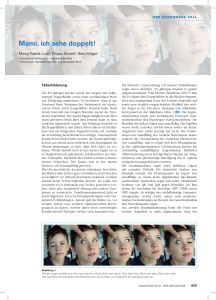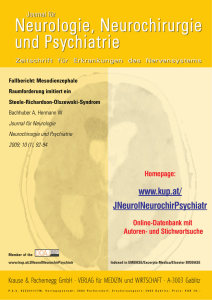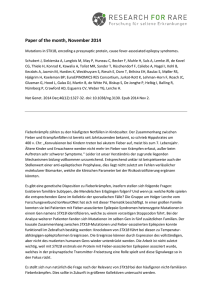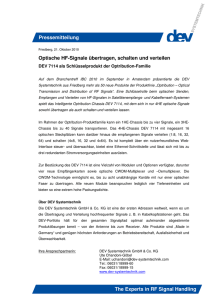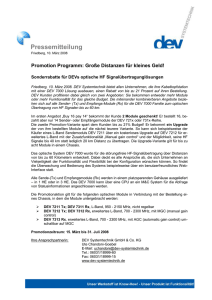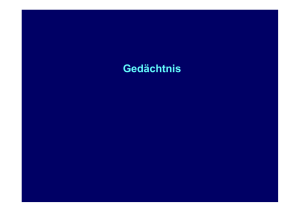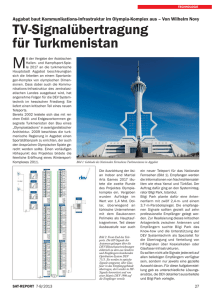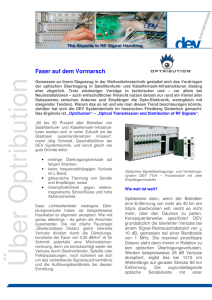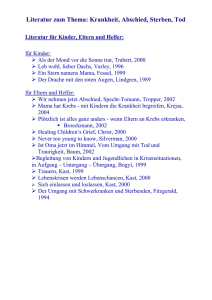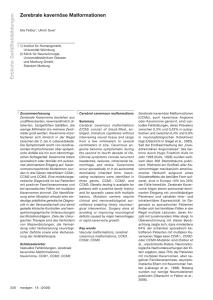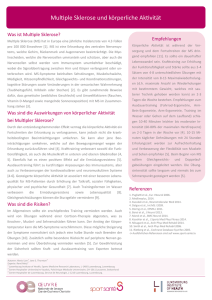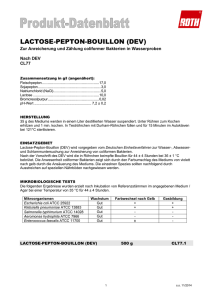Entwicklungsneurologische Therapie und seine
Werbung
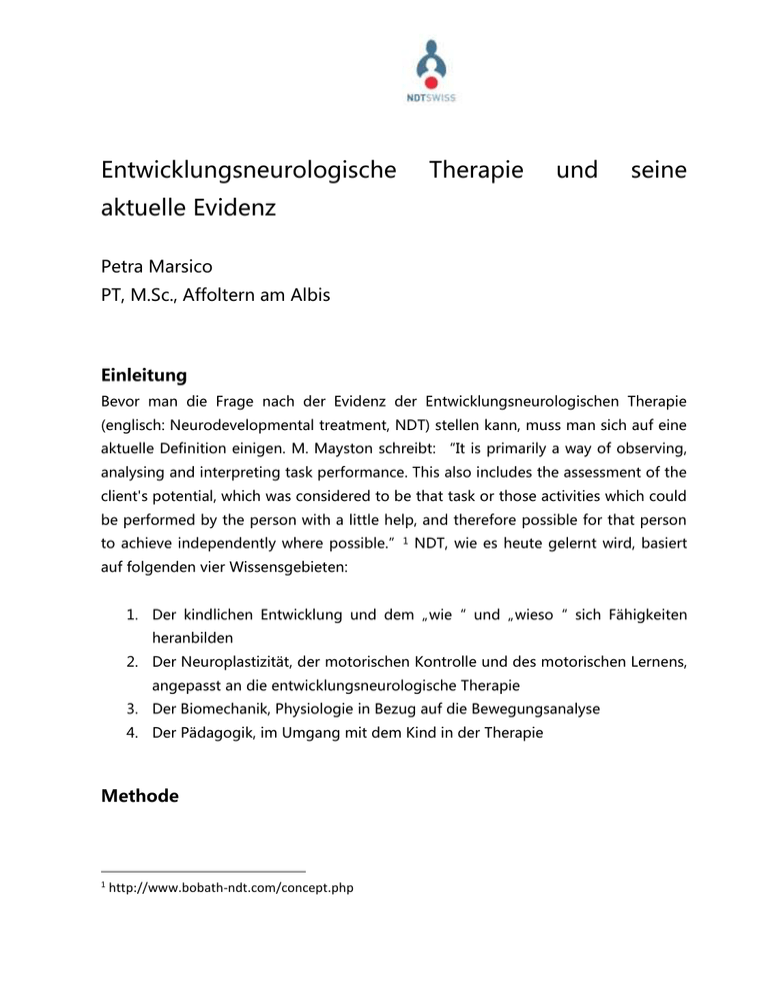
Entwicklungsneurologische Therapie und seine aktuelle Evidenz Petra Marsico PT, M.Sc., Affoltern am Albis Einleitung Bevor man die Frage nach der Evidenz der Entwicklungsneurologischen Therapie (englisch: Neurodevelopmental treatment, NDT) stellen kann, muss man sich auf eine aktuelle Definition einigen. M. Mayston schreibt: “It is primarily a way of observing, analysing and interpreting task performance. This also includes the assessment of the client's potential, which was considered to be that task or those activities which could be performed by the person with a little help, and therefore possible for that person to achieve independently where possible.”1 NDT, wie es heute gelernt wird, basiert auf folgenden vier Wissensgebieten: 1. Der kindlichen Entwicklung und dem „wie“ und „wieso“ sich Fähigkeiten heranbilden 2. Der Neuroplastizität, der motorischen Kontrolle und des motorischen Lernens, angepasst an die entwicklungsneurologische Therapie 3. Der Biomechanik, Physiologie in Bezug auf die Bewegungsanalyse 4. Der Pädagogik, im Umgang mit dem Kind in der Therapie Methode 1 http://www.bobath-ndt.com/concept.php Um nun den aktuellen Stand der wissenschaftlich publizierten Arbeiten in Bezug auf NDT zu ermitteln, fand eine systematische Datenbank Literatursuche Pubmed, Suchbegriffen, statt: mit in der folgende „Cerebral palsy“ NOT „adults“, „neurodevelpmental treatment“ OR „bobath“. Eingeschlossen wurden Artikel, welche die Effektivität von NDT untersuchen, ab dem Publikationsjahr 2000. Resultate Die Artikel im Bereich Ergotherapie untersuchen die Effektivität der Behandlung auf Struktur bis Aktivitätsebene (1–3). In einer Studie wird die Ebene der Partizipation ebenfalls berücksichtigt (4). Eine Studie evaluiert das Fachwissen von Ergotherapeuten vor und nach einem Bobath-Grundkurs (5). Die 15 Artikel im Bereich Physiotherapie untersuchen sehr unterschiedliche Bereiche der Effektivität von Muskeldicke bis zu individuell definierten Zielen auf Aktivitäts- und Partizipationsebene (6–20). Die drei Artikel der Logopädie belichten das Handling und Positionieren in Bezug auf die oralsensomotorische Behandlung und die Langzeitbegleitung von 10 Kindern mit Dysarthrie (21–23). Diskussion Der Evidenz-Level der Studien2 variiert stark von einzelnen randomisierten kontrollierten Studien bis hin zu Fallbeispielen. Dies und ebenfalls die sehr unterschiedlich eingesetzten Messinstrumente, erlauben anhand der aktuell vorliegenden Literatursuche, keine abschliessende Beurteilung zur der Effektivität von 2 http://www.aacpdm.org/UserFiles/file/systematic-review-methodology.pdf NDT. Jedoch geht es in der Behandlung um jedes einzelne individuelle Kind, welches eine für sich und seine Familie „zugeschnittene“ Therapie benötigt (24). Die Resultate der Studien sollen die Therapeuten in ihrem Prozess des „Clinical reasoning“ unterstützen um die Behandlung optimal zu gestalten. Daher bildet jede publizierte Studie einen kleinen Schritt in Richtung „Evidence based therapy“. 1. Grazziotin dos Santos C, Pagnussat AS, Simon a. S, Py R, Pinho AS Do, Wagner MB. Humeral external rotation handling by using the Bobath concept approach affects trunk extensor muscles electromyography in children with cerebral palsy. Res Dev Disabil. 2015;36:134–41. 2. Labaf S, Shamsoddini A, Hollisaz M, Sobhani V, Shakibaee A. Effects of Neurodevelopmental Therapy on Gross Motor Function in Children with Cerebral Palsy. Iran J Child Neurol. 2010;9(2):341–7. 3. Arndt SW, Chandler LS, Sweeney JK, Sharkey MA, McElroy JJ. Effects of a neurodevelopmental treatment-based trunk protocol for infants with posture and movement dysfunction. Pediatr Phys Ther. 2008 Jan;20(1):11–22. 4. Law MC, Darrah J, Pollock N, Wilson B, Russell DJ, Walter SD, et al. Focus on function: a cluster, randomized controlled trial comparing child- versus context-focused intervention for young children with cerebral palsy. Dev Med Child Neurol. 2011;53(7):621–9. 5. Rezaei M, Malekpour M, Rassafiani M. Assessment of Knowledge of Iranian Occupational Therapists of Handling of Children with Cerebral Palsy. Occup Ther Int. 2014. 6. Lee M, Ko Y, -Sook Shin M, Lee W. The effects of progressive functional training on lower limb muscle architecture and motor function in children with spastic cerebral palsy. 2015;2–6. 7. Evans-Rogers DL, Sweeney JK, Holden-Huchton P, Mullens P a. Short-term, Intensive Neurodevelopmental Treatment Program Experiences of Parents and Their Children With Disabilities. Pediatr Phys Ther. 2015;27(1):61– 71. 8. Yonetsu R, Iwata A, Surya J, Unase K, Shimizu J. Sit-to-stand movement changes in preschool-aged children with spastic diplegia following one neurodevelopmental treatment session – a pilot study. Disabil Rehabil. 2015;37(18):1643–50. 9. Bar-Haim S, Harries N, Nammourah I, Oraibi S, Malhees W, Loeppky J, et al. Effectiveness of motor learning coaching in children with cerebral palsy: a randomized controlled trial. Clin Rehabil. 2010 Nov;24(11):1009–20. 10. Bar-Haim S, Harries N, Belokopytov M, Frank A, Copeliovitch L, Kaplanski J, et al. Comparison of efficacy of Adeli suit and neurodevelopmental treatments in children with cerebral palsy. Dev Med Child Neurol. 2006;48(5):325– 30. 11. Czupryna K, Nowotny J. Foot and Knee Behaviour During Gait in Response to the Use of Additional Means of Treatment in Celebral Palsied Children. Ortop Traumatol Rehabil [Internet]. 2012;14(5):7–7. 12. Tsorlakis N, Evaggelinou C, Grouios G, Tsorbatzoudis C. Effect of intensive neurodevelopmental treatment in gross motor function of children with cerebral palsy. Dev Med Child Neurol. 2004 Nov;46(11):740–5. 13. Knox V, Evans AL. Evaluation of the functional effects of a course of Bobath therapy in children with cerebral palsy: a preliminary study. Dev Med Child Neurol. 2002 Jul;44(7):447–60. 14. Kerem M, Livanelioglu a, Topcu M. Effects of Johnstone pressure splints combined with neurodevelopmental therapy on spasticity and cutaneous sensory inputs in spastic cerebral palsy. Dev Med Child Neurol. 2001;43(5):307–13. 15. Mahoney G, Robinson C, Fewell RR. The effects of early motor intervention on children with Down syndrome or cerebral palsy: a field-based study. J Dev Behav Pediatr. 2001;22(3):153–62. 16. Adams MA, Chandler LS, SChuhmann K. Gait Changes in Children with Cerebral Palsy Following a Neurodevelopmental Treatnment Course. Pediatr Exerc Sci. 2000;12:114–20. 17. Bialosky JE, Bishop MD, Price DD, Robinson ME, Vincent KR, George SZ. A randomized sham-controlled trial of a neurodynamic technique in the treatment of carpal tunnel syndrome. J Orthop Sports Phys Ther. 2009 Oct;39(10):709–23. 18. Simon ADS, Pinho AS Do, Grazziotin dos Santos C, Pagnussat ADS. Facilitation handlings induce increase in electromyographic activity of muscles involved in head control of Cerebral Palsy children. Res Dev Disabil. Elsevier Ltd.; 2014;35(10):2547–57. 19. Cherng R-J, Liu C-F, Lau T-W, Hong R-B. Effect of treadmill training with body weight support on gait and gross motor function in children with spastic cerebral palsy. Am J Phys Med Rehabil. 2007 Jul;86(7):548–55. 20. Hazneci B, Tan AK, Guncikan MN, Dincer K, Kalyon TA. Comparison of the efficacies of botulinum toxin A and Johnstone pressure splints against hip adductor spasticity among patients with cerebral palsy: a randomized trial. Mil Med. 2006;171(7):653–6. 21. Santos MTBR, Manzano FS. Assistive stabilization based on the neurodevelopmental treatment approach for dental care in individuals with cerebral palsy. Quintessence Int. 2007 Sep;38(8):681–7. 22. Puyuelo M, Rondal J a. Speech rehabilitation in 10 Spanish-speaking children with severe cerebral palsy: A 4-year longitudinal study. Dev Neurorehabil. 2005 Jan;8(2):113–6. 23. Hirata G, Santos R. Rehabilitation of oropharyngeal dysphagia in children with cerebral palsy: A systematic review of the speech therapy approach. Int Arch Otorhinolaryngol. 2013;16(03):396–9. 24. Van den Broeck C, De Cat J, Molenaers G, Franki I, Himpens E, Severijns D, et al. The effect of individually defined physiotherapy in children with cerebral palsy (CP). Eur J Paediatr Neurol. Elsevier Ltd; 2010 Nov;14(6):519–25.
